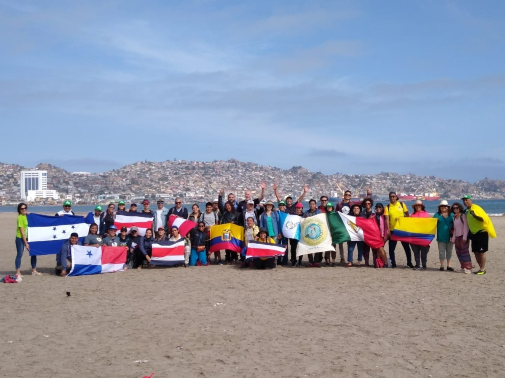Bottle with a message: Story writing connects children to the environment
Posted on 20 December 2022
 Researchers on the project in Chile
Researchers on the project in Chile
The team, including the Universities of York, Plymouth, and Universidad Católica del Norte, Coquimbo (Chile), looked at school children’s perceptions of marine plastic litter in Latin American countries along the Pacific and examined the impact of the story-writing activity on the children’s perceptions and their behaviours.
Imaginations
The researchers encouraged the children to use their imaginations about common litter items found on the beach and in the marine environment, which included toys, a plastic bag, toothbrush, bottle, and straw and how they came to be in the ocean.
By imagining the journey these items had taken, they were able to think about ways of preventing the litter from entering the environment on the East Pacific Coast.
The activity showed that through story writing, children mostly focused on preventing the problem from worsening, rather than cleaning up existing litter, with the most popular solution being adequate disposal of litter and recycling. Other solutions included reducing plastic use, reusing items, education and convincing the community of the importance of the issue.
Participants
During the COVID-19 lockdowns, schoolchildren from the East Pacific coast participated in this activity, creating a story, and answering a pre-post survey. The participating children were part of the school citizen science program “Científicos de la Basura” (Litter Scientists), in which schoolteachers together with their classes investigate the problem of marine litter along the coasts of Latin America.
The study was designed and timed to give schoolchildren in this region an activity to engage with while the schools were closed, and they were experiencing isolation.
In total, 89 children aged between 10 and 18 years old took part in the study from countries along the Pacific coast, including Chile, Colombia, Costa Rica, Ecuador, Mexico, Panama and Peru.
Lead author of the study, Estelle Praet from the Department of Archaeology at the University of York, said: “Stories offer a new and different way to explore what people believe and how they perceive and make sense of their environment, including in this study, marine plastic litter. The results were truly inspiring and showed the children’s awareness of plastic's impact on marine life and the environment.”
Awareness
The children were given a choice of items and asked to create a fictional story, to reflect on the plastic pollution problem. More than half of the children’s stories showed awareness of the harmful nature of plastics when interacting with marine life, including when animals ingest plastic, get entangled or become intoxicated by the components of the plastic.
Many of the stories described several consequences, including injuries, death, impact on the environment and the widespread effects on beach aesthetics. Co-author Diamela de Veer from the Científicos de la Basura program at Universidad Católica del Norte in Chile highlighted the similarities with another recent study: “In a previous activity, the schoolchildren had visited the beaches and made drawings of their beaches before and after the visit - many of these drawings also contained litter items, including some of them showed interactions between litter and marine life, underscoring that they notice the environmental problem caused by litter.”
Professor John Schofield, from the Department of Archaeology, said: “By viewing these plastic items as artefacts, each with its own story, we can bring this back to the human behaviours that related to the objects' use and their disposal. This project has helped show how we can get that message across to children and hopefully then make a difference.”
Findings
By developing stories around the items and recognising that human behaviours are at the root of plastic pollution, this exercise was also found to have an impact on the children themselves.
Dr Kayleigh Wyles, an environmental psychologist from the University of Plymouth who contributed to the paper, said: “A key element of our project was to examine the children’s responses to questionnaires they completed before and after writing these stories. We found that their knowledge on the topic increased and they became more proactive, as they reported doing more pro-environmental acts afterwards.”
The stories themselves also highlighted the importance of individual action, with 77% of the stories including possible solutions that people can do to help address this global issue.
This research, also in partnership with institutions and NGOs in the UK and Mexico, is funded by the Galapagos Conservation Trust and the Global Challenges Research Fund as part of the Pacific Plastics: Science to Solutions (PPSS) programme, and published in the journal Marine Pollution Bulletin.
Explore more news

Character from unfinished Jane Austen novel reimagined in special portrait
Thursday 31 July 2025

“Window of opportunity” to address heritage concerns of Cambridgeshire rail project, say researchers
Tuesday 29 July 2025

Poor diets fuelling health crisis in the North, report reveals
Wednesday 23 July 2025

Nightjars at real risk from decreasing genetic diversity, researchers warn
Tuesday 22 July 2025

A ‘millet mystery’ in ancient Japan reveals a complex picture of agricultural adoption, research shows
Monday 21 July 2025
Media enquiries
About this research
The team, including the Universities of York, Plymouth, and Universidad Católica del Norte, Coquimbo (Chile), looked at school children’s perceptions of marine plastic litter in Latin American countries along the Pacific and examined the impact of the story-writing activity on the children’s perceptions and their behaviours.
This research, also in partnership with institutions and NGOs in the UK and Mexico, is funded by the Galapagos Conservation Trust and the Global Challenges Research Fund as part of the Pacific Plastics: Science to Solutions (PPSS) programme, and published in the journal Marine Pollution Bulletin.
Link to all the children's stories: https://doi.org/10.5281/zenodo.7411595
Translated from Galapagos Conservación Trust website: https://galapagosconservation.org.uk/reciba/
